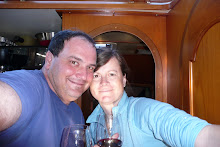We’ve ripped out our old counters and will soon proceed with installing new, but what. We have a quote on installing a manufactured quartz and were a little shocked by the installation bid. I had a long chat with a professional installer of granite and quartz and he really opened my eyes to what goes into a bid. He also recommended we go with a solid surface instead of the quartz, even though he does not sell solid surface. The information below is what I gleaned from our conversation.
Why is that labor bid so high? Think about how the countertop installer will access the galley. Installation can easily be twice the cost (or more) that it would be for a home as the installer may have to travel a considerable distance down a dock (maybe with a locked gate and steep ramp) to get to your boat, then once there, access from the dock onto the boat, through the door and into the galley can be quite challenging. If the installer is not figuring this into the cost, they will once they come to your vessel to do the actual measurement!
What type of surface? You can easily find comparisons on the web that look at things like heat and scratch resistance of various surfaces and that provide information on care and maintenance. Granite and manufactured stone are quite popular and are being done on boats, but a solid surface, such as Corian, may be a more practical choice depending on your layout. Consider the weight difference. A square foot of manufactured quartz, like Silestone, is easily ten pounds and is about three quarters of an inch thick. A solid surface like Corian is about half an inch thick and that same square foot is going to be light, maybe a couple of pounds, and would be like picking up a cutting board. If your boat has any kind of hatches in the counter, this is a big consideration. Many boats have corner storage with the only access being through lifting out a piece of the counter. Not only would a quartz hatch be quite heavy, there is a good possibility of chipping the corners of the hatch of scratching the counter when you set the hatch down. Or perhaps even breaking the hatch or dropping it if you, since as we know sometimes the boat lurches when you are not expecting it, even at anchor if someone wakes you! Sailboats often have reach in refrigerators where large sections of the counter are removable for access. Imagine what that would weigh in granite. There is a reason a lot of sailboat manufactures are using solid surface counters these days.
All that being said, I am not sure whether we will stick to the Silestone we picked out or go with a solid surface. We have to give it considerably more thought and see the Corian quote before we decide.
Goines Muses on His Creator’s Two Books
2 days ago



1 comment:
A few things, first you can do acrylics, like Corian, yourself. You use normal woodworking tools with Carbide bits to cut it. Routers, table saws, and circular saws all work on it. I think the weight savings is big, as well as the chip resistance. Another factor is flexibility. The acrylics are going to flex, and not crack as easily as a quartz. I would not use granite as it is very heavy, prone to chipping, and has natural fissures that could easily crack due to the motion of the boat.
Check out Solidsurface.com they have lots of remnants that should be big enough for a galley. I have no affiliation with them, and have not used them. I have though read of a lot of people using them. They also have some thinner materials that you could back up with plywood.
Good luck!
Post a Comment